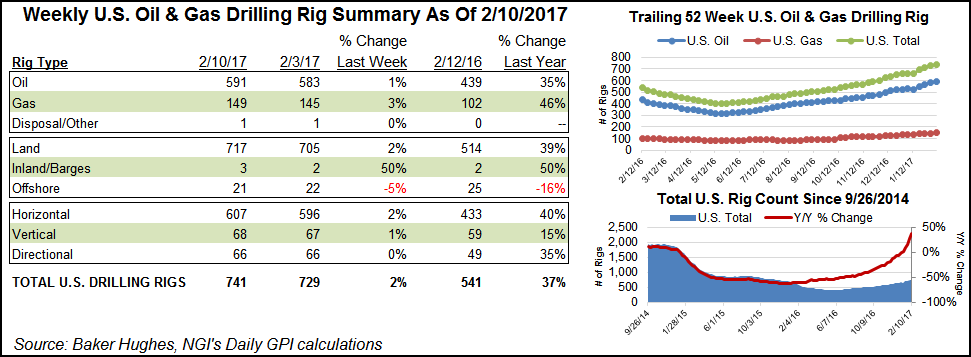Rig Counts Rise; Texas NatGas Production, Completions Languish
Texas and the Permian Basin again led the gainers among states and plays in the latest Baker Hughes Inc. (BHI) rig count. Twelve rigs (mostly oil) returned to U.S. land-based service.

Eight oil rigs and four natural gas rigs returned during the week, BHI said on Friday. Eleven horizontal rigs came back, accompanied by one vertical unit.
One U.S. rig returned to inland waters, and one left the offshore, making for a net U.S. gain of 12 rigs overall. Nine rigs returned to action in Canada (10 oil minus one gas), putting the North American increase at 21 units. The week ended with 717 U.S. land rigs running (741 in the U.S. overall), and 352 rigs running in Canada. The overall North America count was 1,093. These totals are well above year-ago activity levels.
Texas added seven rigs, and the Permian Basin added six. The Marcellus and Eagle Ford each gained three, but the Cana Woodford lost five.
While the focus of most drillers has been oil, the natural gas rig count has been climbing, too. Still, Lower 48 U.S. natural gas production averaged just 70.2 Bcf/d during January, marking the lowest monthly production level recorded since June 2014, according to IHS Markit.
January production represented the second consecutive monthly decline for U.S. natural gas production, and a 1% (0.8 Bcf/d) decrease below December 2016 average production levels. Compared to January 2016, Lower 48 gas production is off 3.4% (2.5 Bcf/d), according to the firm’s data.
Natural gas production declines are not uniform across regions, though, IHS Markit said. While Northeast production has grown, on average, over the past four months and is at an all-time high, production is off in Texas, the firm said.
Texas production only averaged 16.5 Bcf/d of total Lower 48 natural gas production in January, its lowest output since December 2009, according to IHS Markit. “Just one year ago, in January 2016, Texas production was above 18.0 Bcf/d, but waning production in East Texas and in the Eagle Ford in South Texas has had a severe impact on total gas supply for the U.S.” West Texas Permian natural gas production has benefited from increased oil drilling, though, IHS Markit said.
In January the Railroad Commission of Texas (RRC) issued 956 original drilling permits compared to 510 in January 2016. There were 865 permits to drill new oil or gas wells issued, 12 to re-enter plugged wellbores and 79 for recompletions of existing wellbores. Permits were issued for 259 oil, 67 gas, 607 oil or gas, 18 injection, one service and four “other” wells.
In January RRC staff processed 418 oil, 84 gas, 31 injection and three “other” completions compared to 951 oil, 197 gas, 52 injection and four “other” completions in January 2016. Total well completions for 2017 year to date are 536, which is down from 1,204 recorded during the same period in 2016.
© 2024 Natural Gas Intelligence. All rights reserved.
ISSN © 1532-1231 |
